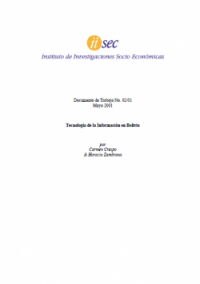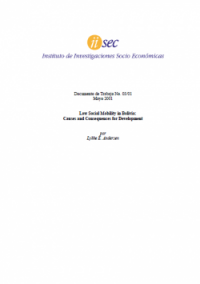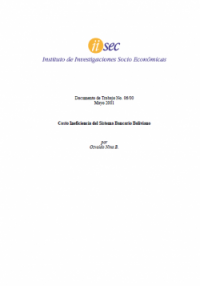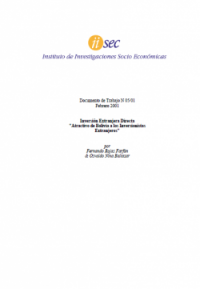-
Tecnología de la Información en Bolivia
Más información »El presente trabajo estudia las principales características y problemas del uso de la Tecnología de Información en Bolivia. Se analizan las condiciones y limitaciones del acceso, el mercado de internet, y el estado en que se encuentran algunos de sus usos específicos. Las recomendaciones finales tienen que ver con modificaciones regulatorias a situaciones que se ...
-
Low Social Mobility in Bolivia: Causes and Consequences for Development
Más información »This paper investigates social mobility in Bolivia. It is an issue of high policy relevance as the degree of social mobility can have strong implications for both poverty reducation and long-run growth. Regressions based on household survey data show that social mobility is very low in Bolivia, even by Latin American standards. This is mainly ...
-
Indicadores de Competitividad
Más información »En este contexto, el análisis de la competitividad de Bolivia, entendida para fines del presente trabajo como: “La capacidad de la economía para generar crecimiento económico y aumentar sus niveles de ingreso” es necesario para identificar aquellos factores que promueven y aquellos que limitan el crecimiento económico de nuestro país. El objetivo del presente trabajo ...
-
Costo Ineficiencia del Sistema Bancario Boliviano
Más información »El trabajo tiene como objetivo determinar los factores que explican los niveles de ineficiencia técnica del sector bancario boliviano en el periodo postliberalización financiera. Los resultados obtenidos mostraron que los factores que explicarían los niveles de ineficiencia son principalmente la competencia en la industria bancaria, los gastos administrativos y la liquidez. La aplicación de las ...
-
Inversión Extranjera Directa "Atractivo de Bolivia a los Inversionistas Extranjeros"
Más información »Durante la década de los noventa, la economía boliviana creció a un ritmo promedio del 4.1%, una de las más altas de la región andina y de Latinoamérica. Este crecimiento, sin embargo, no fue suficiente para lograr un aumento sostenido del ingreso per cápita y superar los niveles de pobreza que subsisten hasta el presente. ...
-
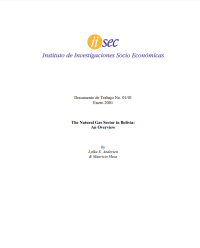
The Natural Gas Sector in Bolivia: An Overview
Más información »This paper provides a thorough overview of the natural gas sector in Bolivia, with the purpose of identifying critical questions to be answered in subsequent research. The paper shows that the Bolivian benefits from natural gas exports are rather limited. The sector generates very little employment, there are few linkages with the rest of the ...
-
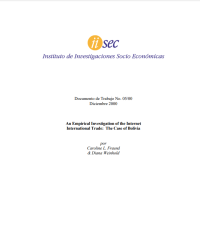
An Empirical Investigation of the Internet International Trade: The Case of Bolivia
Más información »This paper builds on Freund and Weinhold (2000) to show that the results of that paper can be applied to the case of Bolivia. Wc review the implications of the Freund and Weinhold model, emphasizing the effects of the Internet on increasing trade and lessening the effects of historical trading patterns in determining trade flows. ...
-
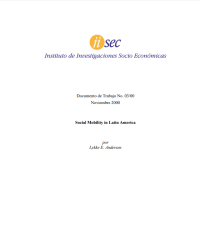
Social Mobility in Latin America
Más información »This paper proposes a new measure of social mobility. It is based on schooling gap regressions, and uses the Fields decomposition to determine the importance of family background in explaining teenagers’ schooling gaps. The method is applied to a sample of 18 Latin American household surveys conducted in the late 1990s. We find Chile, Argentina, ...
-
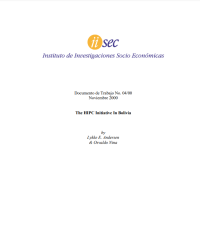
The HIPC Initiative In Bolivia
Más información »This paper discusses the implementation of the Heavily Indebted Poor Country (HIPC) initiative in Bolivia. It has been agreed in principle that the debt relief funds should be channeled to municipal governments in order to strengthen the ongoing decentralization process and to secure maximum poverty reduction effect. If everything goes according to plan, the HIPC ...
-
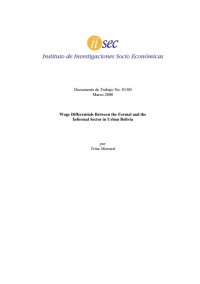
Wage Differentials Between the Formal and the Informal Sector in Urban Bolivia
Más información »This paper analyses wage differentials between the formal and informal sectors in urban Bolivia using household survey data. As m other studies the wage differential between the formal and the informal sector is found to be quite large. The wage gap is estimated by a human capital model correcting for selectivity bias using Heckman’s two-step ...

